Hawks are one of the most majestic birds in North America, and it is important to learn about their behavior and ecology if you want to spot them in the wild.
In this guide, we will provide everything you need to know about hawks in the US. We will discuss their diet, habitat, mating habits, and much more!
Types of Hawks in US
Buteos (Broad-winged Hawks)
Red-Tailed Hawk

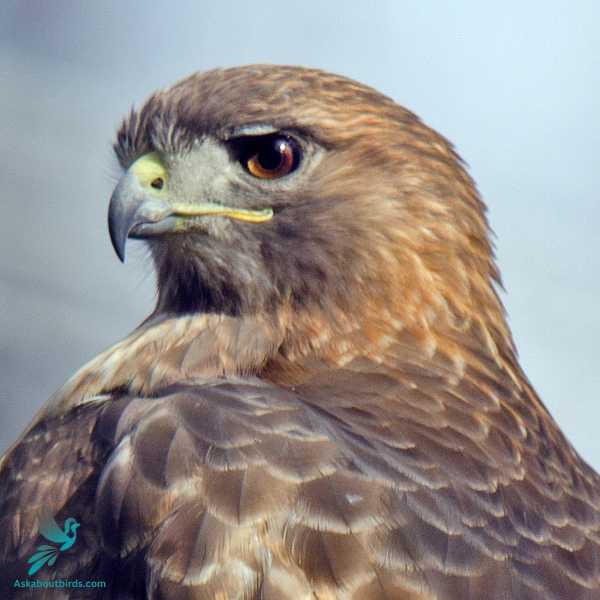
| Feature | Measurement |
|---|---|
| Scientific Name | Buteo jamaicensis |
| Length | 45–65 cm (18–26 in) |
| Wingspan | 110–141 cm (3 ft 7 in – 4 ft 8 in) |
| Weight | 690 to 1,600 g (1.5 to 3.5 lb) |
The Red-Tailed Hawk is a bird of prey that is commonly found across North America. This adaptable raptor is known for its brick-red tail, which is most noticeable in adults from above or underneath. The diet of the Red-Tailed Hawk is very diverse, including small mammals like mice and squirrels, as well as birds and reptiles.
This hawk is often seen perched on poles or soaring in wide circles high above fields, forests, and highways. Its habitat is extremely varied, ranging from desert and scrublands to forests and tropical rainforests. Its call, a raspy, screaming kee-eeeee-arr, is often used in movies to represent any bird of prey.
Broad-Winged Hawk
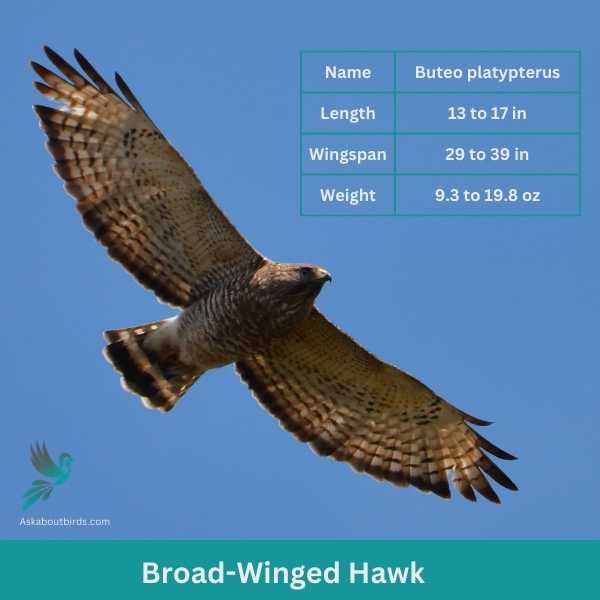

| Feature | Measurement |
|---|---|
| Scientific Name | Buteo platypterus |
| Length | 13 to 17 in |
| Wingspan | 29 to 39 in |
| Weight | 9.3 to 19.8 oz |
The Broad-winged Hawk is a medium-sized bird of prey, belonging to the Buteo genus. It’s primarily found throughout the eastern United States and southern Canada, migrating long distances to Central and South America for the winter. The bird is named for its relatively broad wings, and it displays a characteristic white band on the tail, which is bordered by two darker bands.
Broad-winged Hawks inhabit deciduous forests and woodlands, where they primarily feed on small mammals, amphibians, insects, and occasionally birds. They are known for their distinctive soaring flight during migration, often traveling in large groups known as “kettles.” These hawks are monogamous and build nests high in trees where the female usually lays 1 to 3 eggs. Their call is a piercing, two-parted whistle, heard most frequently during the breeding season.
Swainson’s Hawk
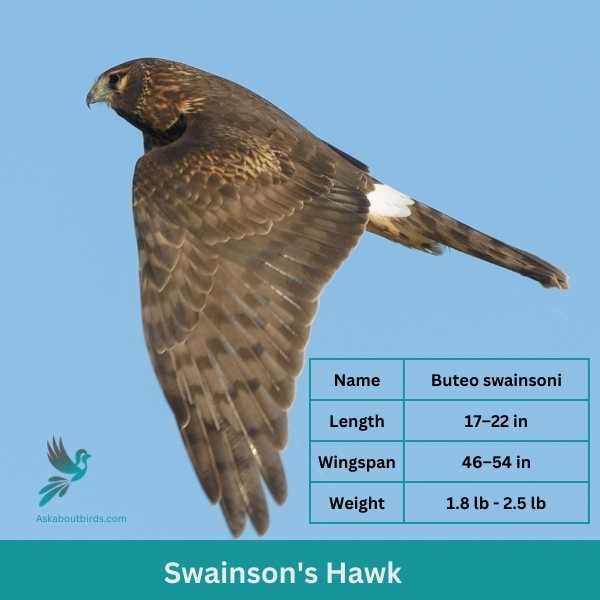

| Feature | Measurement |
|---|---|
| Scientific Name | Buteo swainsoni |
| Length | 17–22 in |
| Wingspan | 46–54 in |
| Weight | 1.8 lb – 2.5 lb |
Swainson’s Hawk, a raptor in the Buteo genus, is recognized by its long wings and somewhat small bill. Named after British ornithologist William Swainson, this hawk is notable for its long-distance migration, travelling from its breeding grounds in North America to wintering areas in Argentina, one of the longest migratory journeys of any American raptor.
The diet of Swainson’s Hawks changes with the seasons. During the breeding season, they primarily feed on rodents and birds (burrowing owls if they are in abundance), while they shift to a diet of insects, especially grasshoppers and beetles, during migration and in their wintering grounds. They are also known for their soaring flight pattern and their distinctive two-part call that sounds like a plaintive whistle.
Rough-legged Hawk
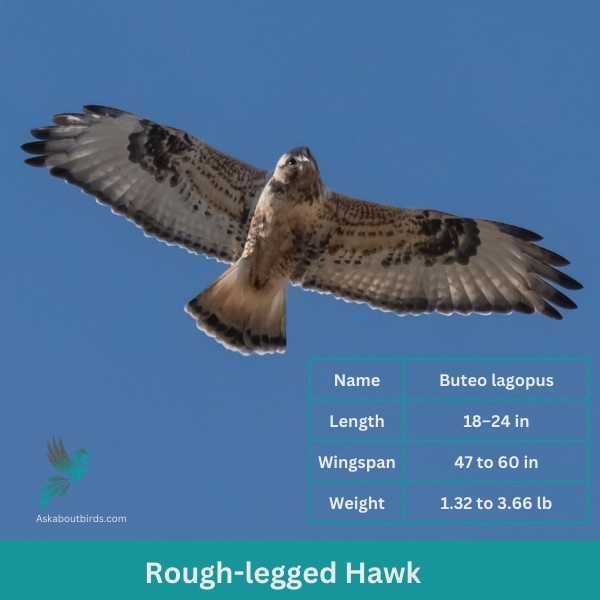
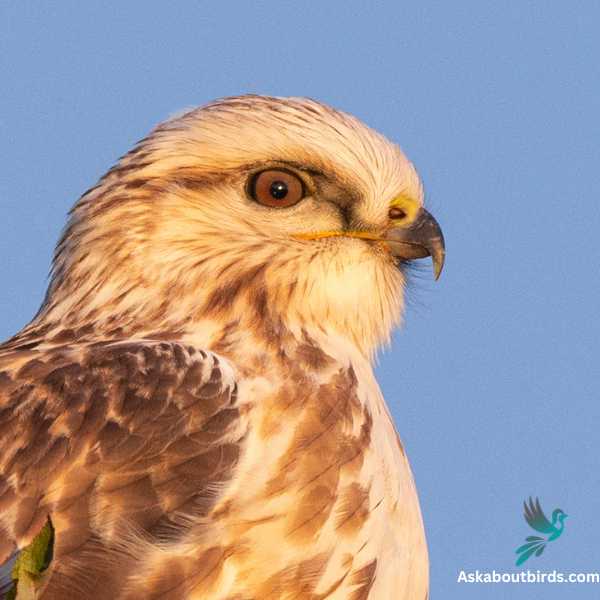
| Feature | Measurement |
|---|---|
| Scientific Name | Buteo lagopus |
| Length | 18–24 in |
| Wingspan | 47 to 60 in |
| Weight | 1.32 to 3.66 lb |
The Rough-legged Hawk, also a member of the Buteo genus, is named for its feathered legs that are adapted to cold environments in its Arctic breeding grounds. Characterized by a wide variety of plumage, all individuals display a characteristic dark “wrist” patch on the underwing, and a white base to the tail. The light morphs are predominantly white and brown, while the dark morphs are more uniformly dark brown.
Rough-legged Hawks are known for their unique hovering flight behavior when hunting for small mammals, which make up a significant portion of their diet. During the breeding season, these hawks are found in the tundra of the Arctic, where they nest on cliffs or bluffs. In winter, they migrate to southern Canada and the northern United States, becoming one of the few raptors that can adjust well to the cold weather conditions.
Ferruginous Hawk

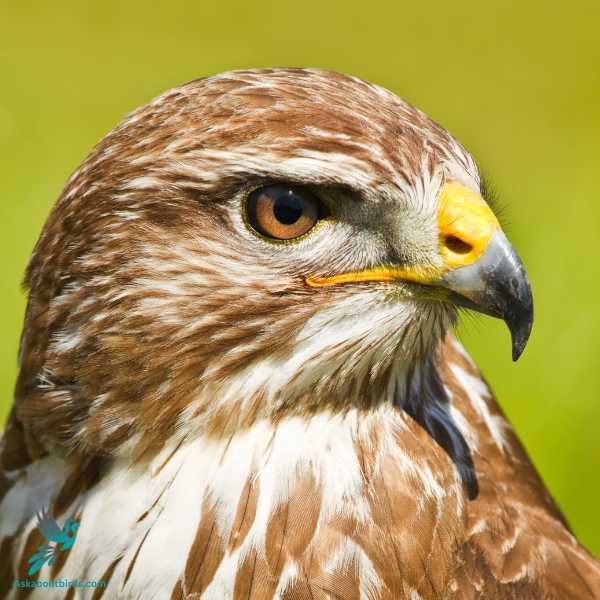
| Feature | Measurement |
|---|---|
| Scientific Name | Buteo regalis |
| Length | 51 to 69 cm (20 to 27 in) |
| Wingspan | 122 to 152 cm (48 to 60 in) |
| Weight | 907 to 2,268 g (32.0 to 80.0 oz) |
The Ferruginous Hawk is a large raptor native to the open landscapes of North America. The term “ferruginous” comes from the Latin word for rust, referring to the bird’s reddish-brown coloration. Ferruginous Hawks are primarily known for their size, broad wings, and a distinctive leg feathering that extends to the toes, a feature that makes them the most “feather-legged” of the North American hawks. This bird feeds primarily on mammals like rabbits and prairie dogs, but will also eat birds and reptiles. They thrive in open habitats such as prairies, plains, and deserts, where they often perch on the highest point available. Their nests are typically constructed on cliffs, trees, or man-made structures and are quite large, reflecting the size of the bird itself. Despite their intimidating presence, Ferruginous Hawks are generally more docile than other raptors.
Red-Shouldered Hawk

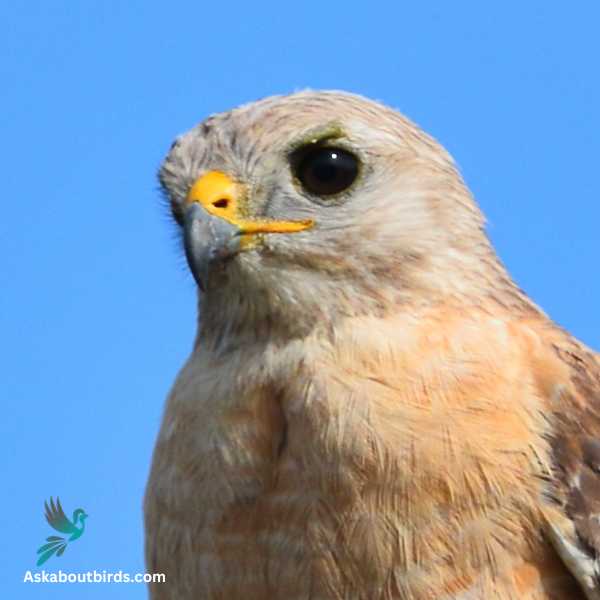
| Feature | Measurement |
|---|---|
| Scientific Name | Buteo lineatus |
| Length | 15 to 23 in |
| Wingspan | 35 to 50 in |
| Weight | 1.21 lb- 1.5 lb |
The Red-Shouldered Hawk is a medium-sized bird of prey, belonging to the Buteo genus, prevalent in North America. It is characterized by its reddish-brown shoulder patches, from which it derives its name. Other distinctive features include its banded tail and translucent crescents near the wingtips that are visible during flight.
Red-Shouldered Hawks typically inhabit mixed woodlands, often near rivers and swamps, where they hunt for a variety of prey, including small mammals, amphibians, reptiles, and occasionally other birds. Unlike some other hawk species, they are quite vocal, emitting a distinctive, repetitive whistle that often gives away their presence. These hawks build nests high in deciduous trees where they usually lay 2 to 4 eggs. The pairs are monogamous, often maintaining their bond for many years and defending their territories fiercely.
Zone-Tailed Hawk
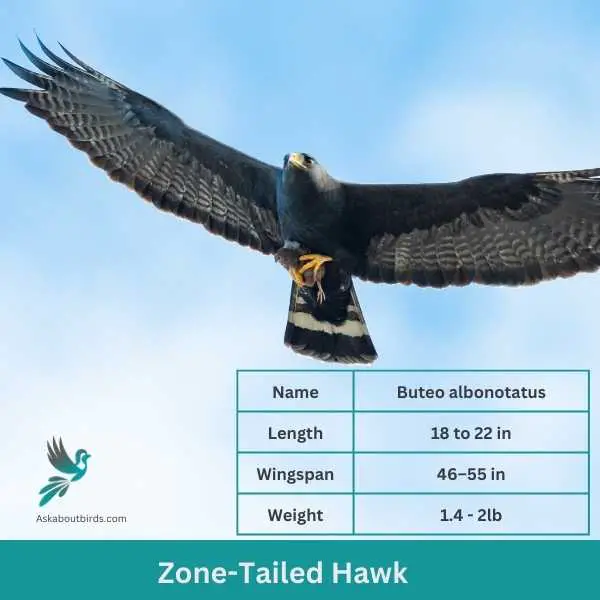
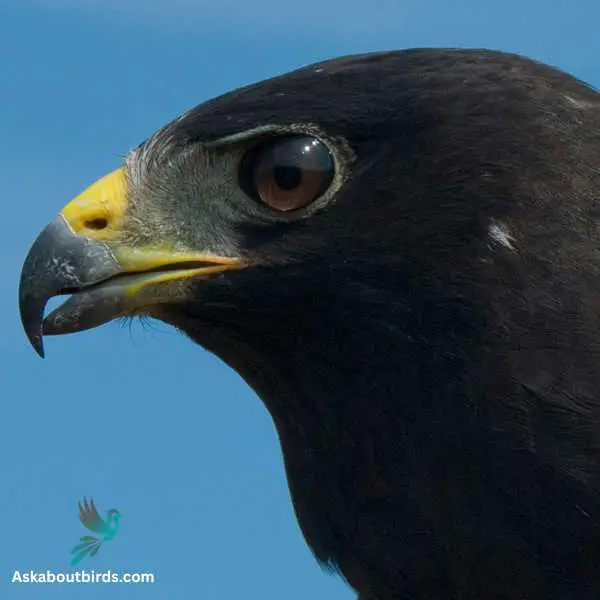
| Feature | Measurement |
|---|---|
| Scientific Name | Buteo albonotatus |
| Length | 18 to 22 in |
| Wingspan | 46–55 in |
| Weight | 1.4 – 2lb |
The Zone-Tailed Hawk (Buteo albonotatus) is a medium-sized bird of prey that can be found in parts of North, Central, and South America. Its most striking feature is its distinct tail, which displays a series of black and white bands, providing this raptor its descriptive name. This bird has a largely blackish plumage, which combined with its tail banding, and general shape and flight pattern, makes it often mistaken for the common Turkey Vulture, a case of Batesian mimicry that can allow it to approach prey unnoticed.
Its diet is highly varied and opportunistic, consuming a wide range of small mammals, birds, and reptiles. Although the Zone-Tailed Hawk usually hunts by soaring and circling high in the air, it can also stealthily approach prey by flying low to the ground. During the breeding season, these hawks pair up and construct nests out of sticks and plant material, typically in tall trees or cliff edges. Its vocalizations, a series of high-pitched whistles, often signal its presence in the area.
Accipiters (Forest Hawks)
Sharp-Shinned Hawk
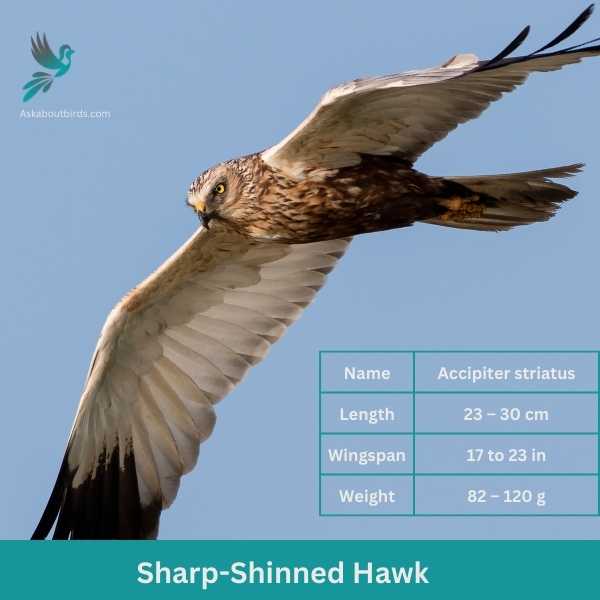

| Feature | Measurement |
|---|---|
| Scientific Name | Accipiter striatus |
| Length | 23 – 30 cm |
| Wingspan | 17 to 23 in |
| Weight | 82 – 120 g |
The Sharp-shinned Hawk is the smallest member of the Accipiter genus found in North America. Noted for its slender body and short, rounded wings, this hawk is characterized by its blue-gray back and barred orange or reddish underparts. The name “sharp-shinned” refers to the bird’s thin, pencil-like lower leg.
Sharp-shinned Hawks inhabit forests and woodlands, where they exhibit agility and stealth in hunting small birds, their primary food source, although they occasionally consume rodents and insects. They’re known for their impressive flight pattern involving quick, successive wingbeats followed by short glides. When it comes to nesting, they favor coniferous trees and both parents participate in raising their young. Their call, often heard during courtship or territory disputes, is a high-pitched, repetitive ‘kik-kik-kik’.
Cooper’s Hawk

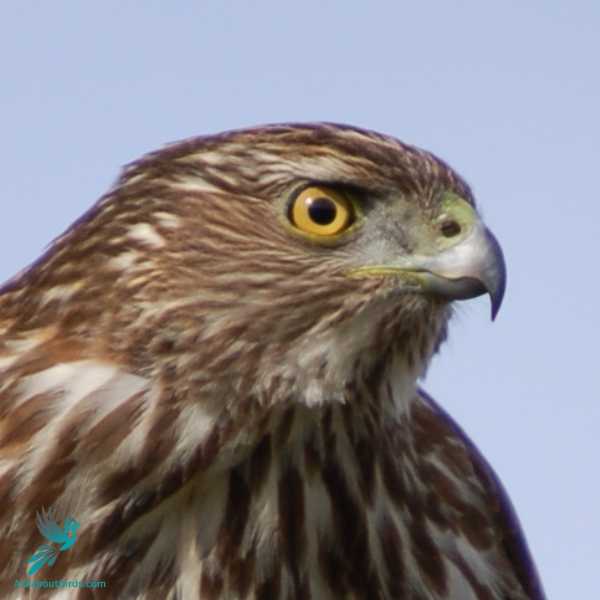
| Feature | Measurement |
|---|---|
| Scientific Name | Accipiter cooperii |
| Length | 35 to 46 cm (14 to 18 in) /Female: 42 to 50 cm (17 to 20 in) |
| Wingspan | 62 to 99 cm (24 to 39 in) |
| Weight | Male: 280 g (9.9 oz) in 48/ Female: 473 g (1.043 lb) |
Cooper’s Hawk is a medium-sized bird of prey in the Accipiter genus, native to the North American continent. It’s named after the American naturalist William Cooper, and distinguished by its slate-gray back, red-barred chest, and rounded tail with broad white terminal band. It is similar in appearance to the smaller Sharp-shinned Hawk, but can be differentiated by its larger size and rounded tail.
Inhabiting various types of woodland and forests, Cooper’s Hawks are agile predators known for their skill at chasing birds through trees, their primary prey being small to medium-sized birds. They also feed on small mammals and, less commonly, reptiles. They’re noted for their explosive flight pattern, consisting of a few rapid wingbeats followed by a short glide. Cooper’s Hawks nest in trees, and both parents share duties of incubating the eggs and raising the young. Their call is a distinctive, repetitive ‘cak-cak-cak’, often heard during courtship or when disturbed.
Northern Goshawk

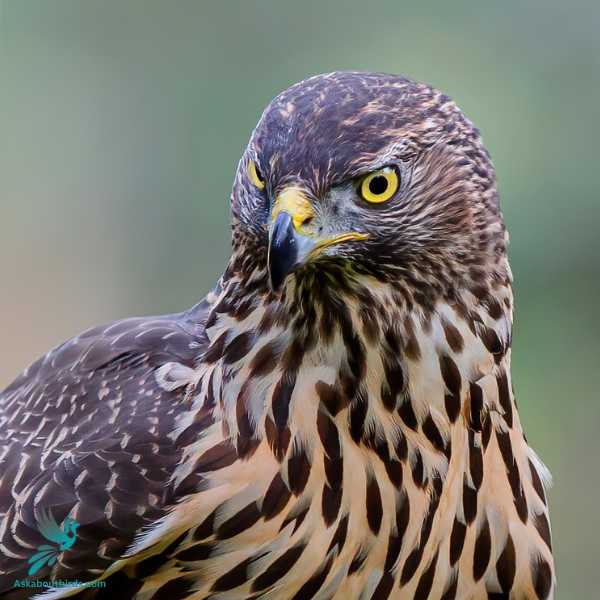
| Feature | Measurement |
|---|---|
| Scientific Name | Accipiter gentilis |
| Length | Male: 46 to 61 cm (18 to 24 in) / Female: 58 to 69 cm (23 to 27 in) |
| Wingspan | 89 to 105 cm (35 to 41 in)/ Female: 108 to 127 cm (43 to 50 in) |
| Weight |
The Northern Goshawk is a large bird of prey and the largest member of the Accipiter genus. Native to the Northern Hemisphere, it’s characterized by its slate-gray upperparts, finely barred underparts, and prominent white eyebrow stripe. The name “goshawk” originates from the Old English term for “goose hawk,” denoting the bird’s prowess at hunting large prey.
Northern Goshawks inhabit large, uninterrupted forests, where they are skilled hunters of a wide range of prey, including small mammals and medium to large birds. They are particularly agile fliers, often chasing prey through densely forested environments. These hawks are monogamous, with pairs often returning to the same nesting territory year after year. Their nests are built high in trees, and their breeding season is heralded by spectacular aerial displays and a loud, repetitive ‘kak-kak-kak’ call.
Harriers
Northern Harrier

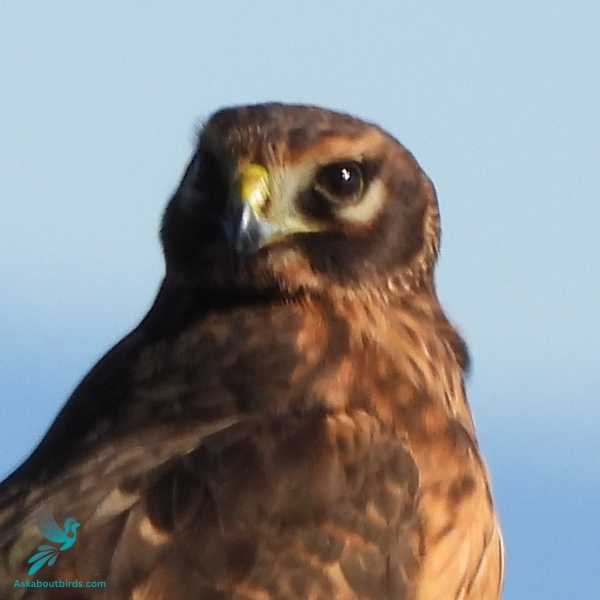
| Feature | Measurement |
|---|---|
| Scientific Name | Circus hudsonius |
| Length | 41–52 cm (16–20 in) |
| Wingspan | 97–122 cm (38–48 in) |
| Weight | Male 10 to 26 ounces (280 to 730 g) Female: 11 to 30 ounces (310 to 850 g) |
The Northern Harrier is a bird of prey that belongs to the Circinae subfamily and stands out due to its distinctively owl-like facial disk, slender body, and long tail. This species exhibits a low and slow flying pattern when hunting, often skimming just above the ground of open fields and marshes. The males are predominantly gray, while the females and young are brown with streaks of white.
Northern Harriers primarily feed on small mammals and birds. Unique among hawks, these birds possess an owl-like trait of using auditory cues as well as visual ones to locate and catch prey. They’re also known for their polygynous breeding system, where a male may have up to five mates at once, each nesting in different locations within his territory.
Other Hawks
Harris’s Hawk


| Feature | Measurement |
|---|---|
| Scientific Name | Parabuteo unicinctus |
| Length | 18 to 23 in |
| Wingspan | 41 to 47 in |
| Weight | 1.2 to 3.6lb |
The Harris’s Hawk is a unique bird of prey and is distinct in appearance compared to many other hawk species. It boasts a beautiful color palette, with dark brown plumage contrasted by chestnut-red shoulders, wing linings, and thighs, and a white patch at the base of the tail. This raptor has a reputation for its unusual social behavior, being one of the only bird species that hunts cooperatively in packs.
A native to the arid southwest regions of the United States, Mexico, and South America, the Harris’s Hawk prefers habitats like scrub desert, savannas, and woodland edges. While not typically found in Louisiana, it may appear in the state as a vagrant. These birds are known for their agility and hunting prowess, often pursuing prey on the ground and from low perches. Their diet mainly consists of small mammals and birds, but they’ve also been known to take larger prey such as jackrabbits and hares.
White-Tailed Hawk
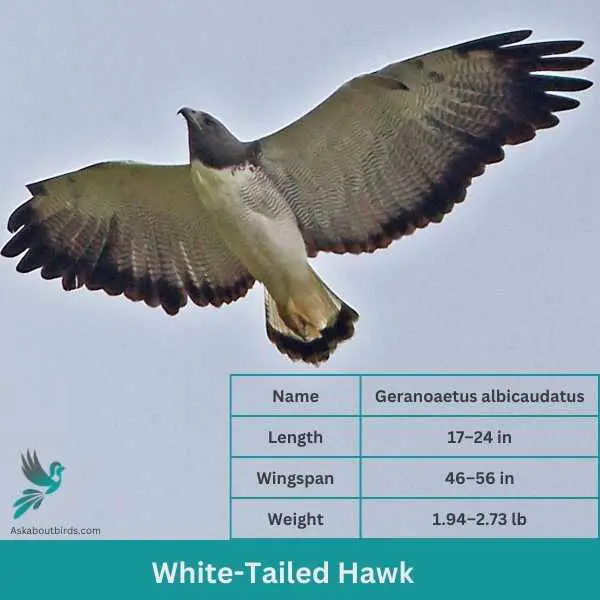

| Feature | Measurement |
|---|---|
| Scientific Name | Geranoaetus albicaudatus |
| Length | 17–24 in |
| Wingspan | 46–56 in |
| Weight | 1.94–2.73 lb |
The White-Tailed Hawk is a large bird of prey that ranges across both North and South America. Recognizable by its predominantly gray body and white underparts, this raptor is most distinguished by its white tail adorned with a single, broad black band near the tip. Younger hawks often have rufous markings on their upperparts, which fade to gray as they mature.
The White-Tailed Hawk is a formidable hunter with a broad diet that includes small mammals, birds, and reptiles. It’s known for its hunting style, typically soaring at high altitudes and diving steeply onto its prey, as well as for its versatility, sometimes hunting from a perch or even on the ground. The hawk’s monogamous breeding pairs construct large, bulky nests, usually situated in the crowns of tall trees or on cliff faces, depending on the habitat.
Common Black Hawk
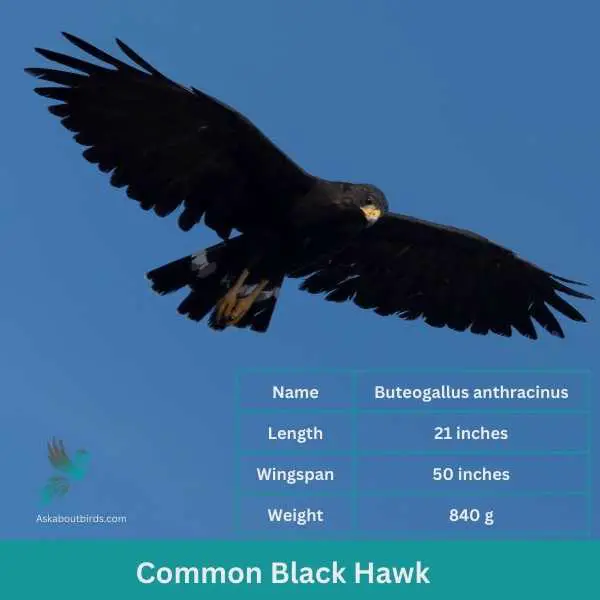
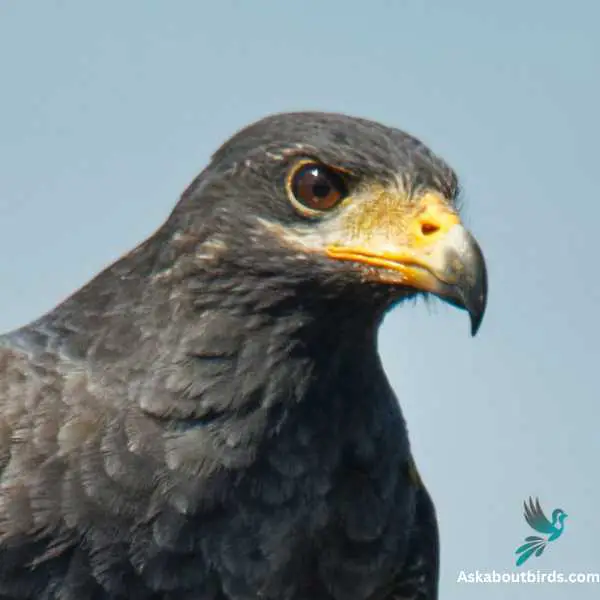
| Feature | Measurement |
|---|---|
| Scientific Name | Buteogallus anthracinus |
| Length | 21 inches |
| Wingspan | 50 inches |
| Weight | 840 g |
The Common Black Hawk (Buteogallus anthracinus) is a bird of prey that inhabits various regions across the Americas. Characterized by its black plumage, this bird is native to coastal and interior regions, ranging from the Southwestern United States to Central America, extending down to parts of South America. In its habitat, it is often found near bodies of water like rivers, streams, and marshes. A distinct feature of this bird is its broad, rounded wings and a short, broad tail which allow it to maneuver through densely forested habitats with relative ease.
A notable behavior of the Common Black Hawk is its preference for aquatic prey. It feeds primarily on crustaceans, fish, amphibians, and other small animals found in or near water. This bird is typically solitary, only forming pair bonds during the breeding season. It builds large stick nests high in trees or on cliff faces near water, demonstrating a strong tie to its preferred aquatic habitats. Vocal and conspicuous during breeding season, these birds are known for their piercing, distinct calls that resonate through their habitats.
Gray Hawk

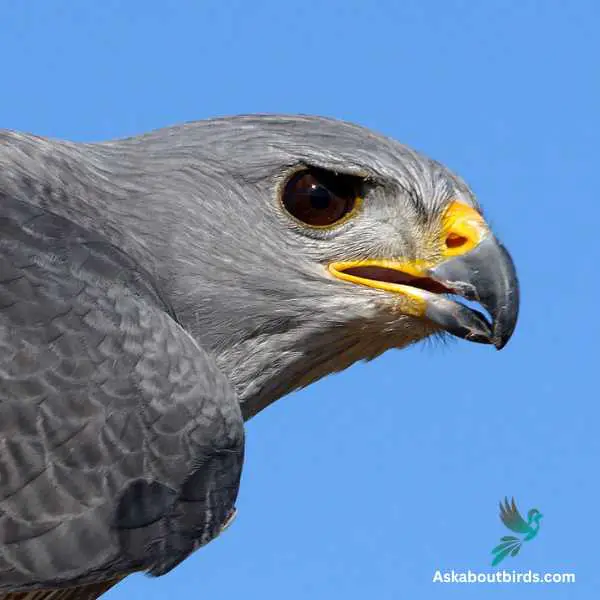
| Feature | Measurement |
|---|---|
| Scientific Name | Buteo plagiatus |
| Length | 18–24 in |
| Wingspan | 31 to 34 inches |
| Weight | 12.5 – 18.8 oz |
The Gray Hawk, also known as the Grey-lined Hawk, is a small bird of prey that is found across a vast range in the Americas, from the southwestern United States through Mexico and Central America, extending to northern South America. It is easily recognizable by its light gray body, darker gray wings, and white underparts with fine gray barring. Its tail is marked with broad white and black bands, giving it a distinctive appearance in flight.
The Gray Hawk is a generalist predator, with a diet that primarily consists of lizards, snakes, small mammals, and birds. It has a unique hunting style, often soaring or perching to locate prey before launching a rapid, direct flight to capture it. The species is monogamous and pairs are known to remain together for multiple breeding seasons. Nests are built high in trees, and both parents participate in the incubation and feeding of the young.
Short-Tailed Hawk


| Feature | Measurement |
|---|---|
| Scientific Name | Buteo brachyurus |
| Length | 15.3-17.3 in |
| Wingspan | 32.7-40.5 in |
| Weight | 13.6-16.9 oz |
The Short-Tailed Hawk is a small to medium-sized bird of prey that inhabits parts of North, Central, and South America. Its name stems from its uniquely short tail, which is prominently visible during its characteristic flight. This bird presents two color morphs: a dark form, which is uniformly dark gray or brownish-black, and a light form, with a primarily white underbody and dark upperparts.
The Short-Tailed Hawk is known for its impressive hunting skills. It predominantly preys on small birds, which it often catches mid-air, but its diet also includes small mammals and reptiles. Hunting usually involves soaring high in the air, sometimes for hours at a time, before diving quickly to snatch its prey. During the breeding season, this raptor constructs a small nest of sticks in the crowns of tall trees.
Hawks by State
Northeast
- New England
- Mid-Atlantic
Southeast
- Hawks in Virginia
- Hawks in West Virginia
- Hawks in North Carolina
- Hawks in South Carolina
- Hawks in Georgia
- Hawks in Florida
- Hawks in Tennessee
- Hawks in Alabama
- Hawks in Mississippi
- Hawks in Arkansas
- Hawks in Louisiana
- Hawks in Kentucky
Midwest
- East North Central
- West North Central
Southwest
West
- Mountain
- Pacific
What is a hawk and what do they look like
Hawks are carnivorous birds and their diet consists mostly of small mammals such as rodents or rabbits. Some species of hawks will also eat reptiles, fish, and insects. Hawks typically hunt from a perch or while flying and use their sharp talons to kill their prey.
Hawks are easily distinguished from other birds of prey by their broad wings and long tails. Hawks come in a variety of colors including brown, gray, white, and black.
The most common type of hawk in the US is the red-tailed hawk. Red-tailed hawks are large birds with a wingspan of up to four feet. They have reddish-brown plumage on their backs and tails, with white and gray undersides.
Hawk habitats in the United States
Hawks can be found in a variety of habitats including forests, grasslands, and deserts. However, they are most commonly found in open areas where there are plenty of trees for them to perch in.
Hawk populations are generally stable and they are not considered to be endangered. However, some species of hawks are more threatened than others. For example, the ferruginous hawk is a type of hawk that is declining in numbers due to habitat loss.
Mating and nesting habits of hawks
Hawks mate for life and typically nest in trees. The female hawk will lay a clutch of eggs (usually three to five) and incubate them for about a month.
Once the chicks hatch, they are cared for by both parents and learn to fly within six weeks. Hawks reach sexual maturity at two years old.
How to identify different hawks
There are many different types of hawks in the US, so it can be tricky to identify them (in fact there are lots of birds that look like hawks which makes it even harder). However, there are a few key characteristics that you can look for.
First, pay attention to the size of the bird. Hawks range in size from about 12 inches to over two feet long.
Second, take note of the coloration. Hawks can be a variety of colors including brown, gray, white, and black.
Finally, look at the shape of the wings. Hawks have broad wings with rounded tips.
Behavior and diet of hawks in the US
Hawks are carnivorous birds and their diet consists mostly of small mammals such as rodents or rabbits. Some species of hawks will also eat reptiles, fish, and insects. Hawks typically hunt from a perch or while flying and use their sharp talons to kill their prey. Do Hawks Hunt at Night Time?
In the wild, hawks typically live for about 20 years.
How to attract hawks to your backyard
If you want to attract hawks to your backyard, there are a few things you can do. First, try putting out a birdbath or small pond. Hawks like to drink and bathe in water, so this will give them a reason to visit your yard.
Second, make sure to provide plenty of perching spots for the hawks. Hawks like to sit in trees or on poles, so try putting out a few birdhouses or nesting boxes.
Finally, don’t forget to provide food! Put out a feeder filled with fresh meat or live insects. This will give the hawks a reason to stick around your yard.
With a little effort, you can turn your backyard into a haven for these magnificent birds!
Conservation status of hawks in the US
Hawk populations are generally stable and they are not considered to be endangered. However, some species of hawks are more threatened than others.
For example, the ferruginous hawk is a type of hawk that is declining in numbers due to habitat loss.
Habitat loss is a major threat to many types of animals, including hawks. Development and agriculture can destroy the open areas that hawks need to hunt and nest.
There are many ways you can help conserve hawks and other birds of prey. One way is to support organizations that work to protect and restore habitats. Another way is to be careful about using pesticides and herbicides, as these can kill the small animals that hawks depend on for food.
By taking steps to conserve these magnificent birds, we can ensure that they will continue to grace our skies for years to come.
Fun facts about hawks in the US
Did you know that there are over 60 different species of hawks in the world? And about 20 of those species can be found in the US!
Hawks come in a variety of colors and sizes, so there’s sure to be one that catches your eye.
These fascinating birds are known for their hunting skills, but did you know that they also mate for life and take care of their young until they learn to fly?




